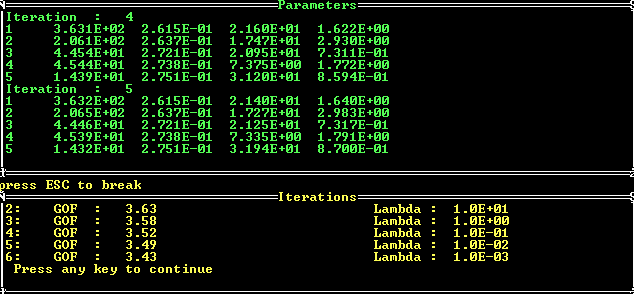
In many cases the direct analysis of diffraction profile is difficult or even impossible because of strong peak overlapping. Then it is necessary to approximate diffraction profiles by suitable analytical functions (separate them by profile fitting).
Fit
All the peaks lying within the current theta limits (the latest in Graphics) are approximated with analytical function after the double selection of Fit. During the fitting the refined parameters after each iteration cycle are shown together with the R- factor (GOF) which should be below about 5% for sufficient approximation. This is, however, dependent to some extent on the noice in the diffraction pattern.
Two mathematical methods can be used for the fitting : SIMPLEX and Levenberg-Marquardt procedure (parameter lambda is decreased by 10 after succesfull iteration. Usually the latter gives better results.
The modification of default parameters for fitting can be done by selecting the item Global parameters . THE MAXIMUM NUMBER OF FITTED PARAMETERS IS 50 ! 'Too many parameters' message appears when there is attempt to fit more parameters.

Global parameters (menu Fit)
Global parameters for fitting can be modified in this menu and analytical function specified in Functions.
Background fitting -
toggle On/Off. The default value depends on the status of BackgroundSubtracted
variable. It should be ON if background has not been subtracted
(in Graphics) for the current pattern, otherwise
it is OFF. However, the status can be changed. It is up to the
user.
Quadratic background -
toggle On/Off (default Off). If set to ON a quadratic background
is fitted to the data.
Range of fit -
default values are taken from the latest graph(current theta
limits). These also determine the number of peaks to be fitted.
The change of range does not affect the number of peaks for
refinement. (The decrease of the range is useful when the weak
reflection is near the strong one. Then both are taken into
fitting but the data points only from interval of the former are
used). If you like to decrease or increase the number of fitted
peaks, it is necessary to change the peak set by Erase
peak or Add peak in the Graphics.
Shape parameters -
Only the a2 /a1 ratio can be changed here in the version 1.5. (default
value is loaded from the configuration file and usually is equal
to 0.5 ). Other shape factors for Ka lines are defined only in
the configuration
file (CONFIG.PRF).
Interval of calculated profile
-
All the peaks included into fitting are calculated in a finite
range given by the number of halfwidths. Initial value is
calculated from the largest halfwidth of the peaks in current
interval. In the item, give the value of the ratio I /Imax for
which the profile can be truncated. The corresponding number of
halfwidths is then automatically derived.
Iterations number -
number of iterations (default 6). Typically 4-10 for Marquardt
method could be sufficient. For Simplex it is multiplied by 10.
Lambda factor -
parameter used in the fitting procedure (default 100). It should
be larger if the starting profile parameters are not too good.
Three parameters for the SIMPLEX method can be changed here.
Simplex -
toggle On/Off. The Levenberg-Marquardt is the default method.
Modification of starting profile parameters - Peaks. Fixing the parameters.
The modification of starting profile parameters can be done by selecting the item Peaks in Fit submenu..
Change parameters:
Current values of XRD line profile parameters for the
peaks of current file (pattern) lying within the current theta
limits are shown in a table and can be changed (find the
parameter to be changed by direction keys and press
<Enter>, then give a new value). The background parameters
are also included.

Fix parameters:
Parameters which are fixed (not refined) during next
refinement cycle are marked by 0 (find the parameter to be fixed
or released by direction keys and press <Enter> - toggle
1/0). The fixing is useful in the case of strongly overlapped or
weak diffraction peaks.
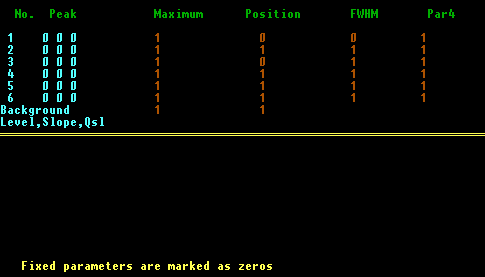
Connect parameters:
Parameters which should be refined simultaneously (the same
increments in iterations) must be denoted by the same numbers. No
gap in numbers is allowed. The binding of parameters can be
useful for shape and width parameters of strongly overlapped
peaks or in the case of long tails.
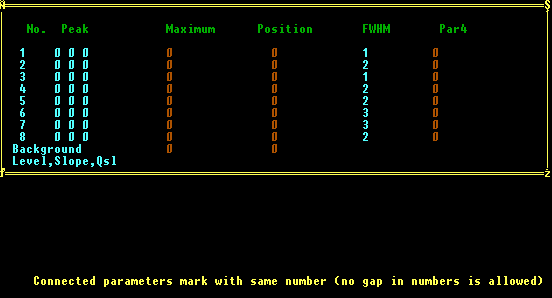
Corrections
The correction toggles are switching on/off the corrections of the polarization, absorption and Lorentz factors. In case of ON they are carried out automatically after the fitting for calculation of all profile parameters. The corrections cannot be performed if they have already been included for whole pattern. There are different ways, how to consider the correction factors.
Drawing the fitting curves
The graphic output of the fitted data can be defined by Graphics submenu of Fit.
Plotting of different curves can be switched on/off.
Fitted curve -
total fitted curve (the sum of contributions of all peaks in the
current segment of the diffraction pattern) is shown. The
experimental data are automatically plotted with dots. In main
graphic menu you can use a shortcut key (<Ctrl F>) for the
toggling.
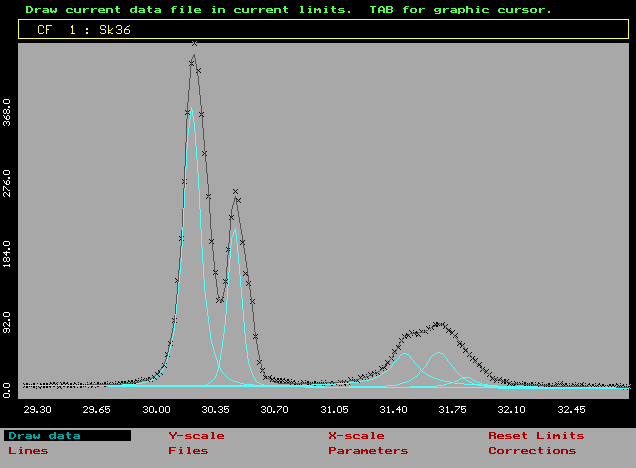
Alpha 1 peaks - individual alpha 1 peaks are plotted
Doublets - individual doublets are plotted
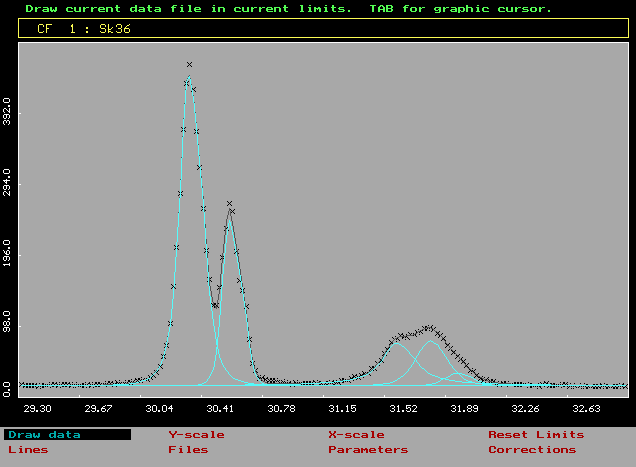
Residua -
the differences between experimental and calculated data are
plotted (cannot be used together with Fine Plot)
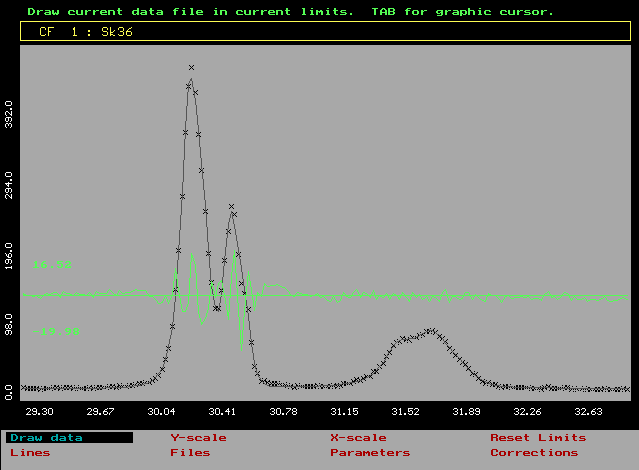
In main graphic menu you can use a shortcut key (<Ctrl D>) for the toggling. Use it only after the fitting. The window for the plot of residua is defined in configuration file.
Fine plot - the fitted profile is calculated with fine step in order a smooth curve could be plottedIn main graphic menu you can use a shortcut key (<Ctrl H> for switching on/off